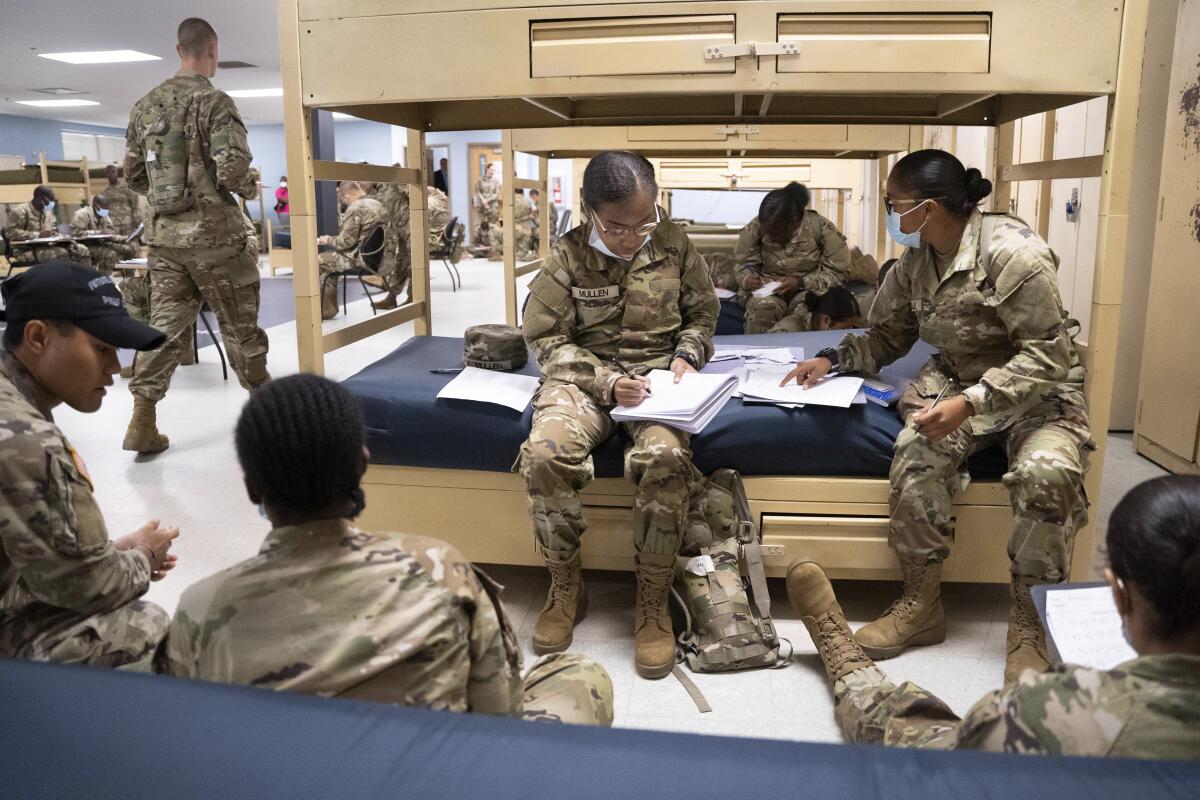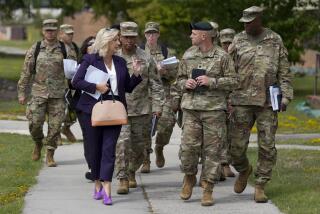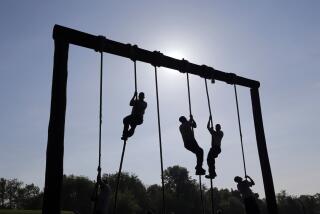Army program gives poor-performing recruits a second chance

- Share via
FORT JACKSON, S.C. — Chaz Andrews has wanted to join the Army since he was 19, but he has failed the service’s academic test more than 10 times over the last decade.
Now, at age 29, Andrews thinks he has a real shot at passing, thanks to a new Army program that gives lower-performing recruits up to 90 days of academic or fitness instruction to help them meet military standards.
“I didn’t want to give up on it,” he said during a recent break in his classroom schedule at Ft. Jackson, where he is one of more than 300 recruits who have been allowed to enlist in the new Army prep course. And if Andrews, who is from Brooklyn, N.Y., is able to raise his test score, he will be allowed to continue on to basic training.
The program, which began in early August, is one way the Army is hoping to fill the ranks as it struggles with recruiting efforts that are expected to fall dramatically short of goals this year. Army officials have described the situation as dire, with some predicting the service may fall 10,000 to 15,000 soldiers short of its recruiting target on Oct. 1, or as much as 18% to 25%.
Military officials, who spoke on the condition of anonymity because the totals are preliminary and could change, said the initial recruiting goal was as high as 60,000 this year, but more realistic expectations later put it at about 55,000. With one month to go, officials are predicting they will come in about 45,000, though it could get better if there is a surge at the end.
Gen. James McConville, the Army chief, traveled to Ft. Jackson on Friday for a firsthand look at the pilot program. He and others have acknowledged the recruiting problems and say they are due to a confluence of events and conditions.
For the first time, the Army is offering a maximum enlistment bonus of $50,000 to highly skilled recruits who sign up for six years.
The COVID-19 pandemic kept recruiters out of schools, fairs and other public events, limiting their in-person contact with students.
Unemployment has been low, other corporate jobs pay well and offer good benefits, and according to estimates, just 23% of young people ages 17 to 24 are physically, mentally and morally qualified to serve without receiving some type of waiver. Moral behavior issues include drug use, gang ties or a criminal record.
The academic and physical fitness requirements are the ones the prep course will address.
“We have some young men and women that want to serve, that have some challenges on the academic and physical side here. And what we want to do is give them that opportunity,” McConville said. He added that the Army will not reduce standards to get more recruits into the service, but will do more to help soldiers make the grade.
Inside the classroom, about 30 recruits in Army fatigues are in their first week of the initial three-week session. On the board, “TAXES” is scrawled in large letters, and students are going through math problems tied to the 6% sales tax. Down the hall, others are tackling rates of speed, calculating how long it will take to travel certain distances.
Other classes focus on reading comprehension and vocabulary. Students get study breaks and personal time. Recruits who failed the fitness standard get classes on nutrition, exercise, physical therapy, sleeping habits and other health skills leading to safe and healthy weight loss.
The fitness training is for recruits who are between 2% and 6% over the body fat standards for their age and gender. The Army routinely allows recruits to go to basic training if they are up to 2% over because they will automatically lose weight and gain muscle during basic training.
The instructors — some former drill sergeants — are in uniform but wear casual ball caps and have toned down their normal cadence. Noting that the sergeants can often be a bit abrasive, commanders said they instead looked for those who can be mature instructors with good temperaments and communication skills.
Staff Sgt. Jonathan Tenorio, who was a drill sergeant and is now an instructor, said it’s less screaming and directing, and more speaking and teaching.
But this is still the Army.
So students’ days start around 5 a.m. and physical training is first on the schedule. They also are learning how to wear their new uniforms, how to march, and how to figure out ranks and other basics of Army culture. And they are learning to live with less social media time — they get to have their phones for only certain parts of the day, not during classes or at night.
Every week they are tested. And every three weeks they can move into basic training if they successfully pass the military’s academic test — which is called the Armed Services Vocational Aptitude Battery — or if they meet the physical standards. They can stay in the program and keep testing for up to 90 days, but have to leave the Army if they don’t pass by then.
Brig. Gen. Patrick Michaelis, the base commander, said many struggle with test-taking skills. The prep course, he said, doesn’t teach answers to the test; it focuses on improving testing skills.
Outside the classroom building, 2nd Lt. William Paschall, a math instructor, said he has seen progress. At the start of the week, he asked how many understood a problem on the board and few hands went up. At the end of the week, nearly all raised their hands.
So far the success rate has been high. In the academic program, 75% of the 333 students tested improved in at least one category, progress that can allow them to move on to basic training. In the fitness program, 73 of the 152 students who began the program have already met the goal and been able to move to basic training.
A dozen students met with McConville, telling him their individual stories. Most said they’ve been trying to get into the Army for a couple years, but were stalled by the academic test. “This is giving me a second chance,” said one. Others talked about looking for a better life and a good job and, as one said, “my final opportunity to get out of the town I lived in.”
Daysia Holiday, 23, said her goal is to become a Green Beret. She’s taken the academic test and failed three times in the last two years, and sees this as her best chance. Holiday, of Baton Rouge, La., said many of her peers didn’t make it out of high school, with some “dead or in jail,” and she wants to set an example for her five younger siblings.
Over time, McConville said he expects the program will expand. Commanders say they believe they can put up to 10,000 through the classes, and it could be set up at three other Army training bases. Other changes could broaden the course so that those who fail both the physical fitness requirements and the scholastic test might be able to get in. Right now, recruits have to meet standards in one of the two.
One week into the course, Andrews is optimistic. “I’ve been trying to do this since I was 19,” he said.
Will he succeed? “Yeah, most definitely,” he said. “It’s very helpful.”
More to Read
Sign up for Essential California
The most important California stories and recommendations in your inbox every morning.
You may occasionally receive promotional content from the Los Angeles Times.











